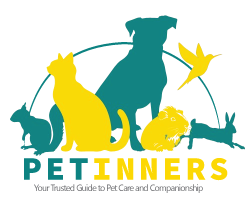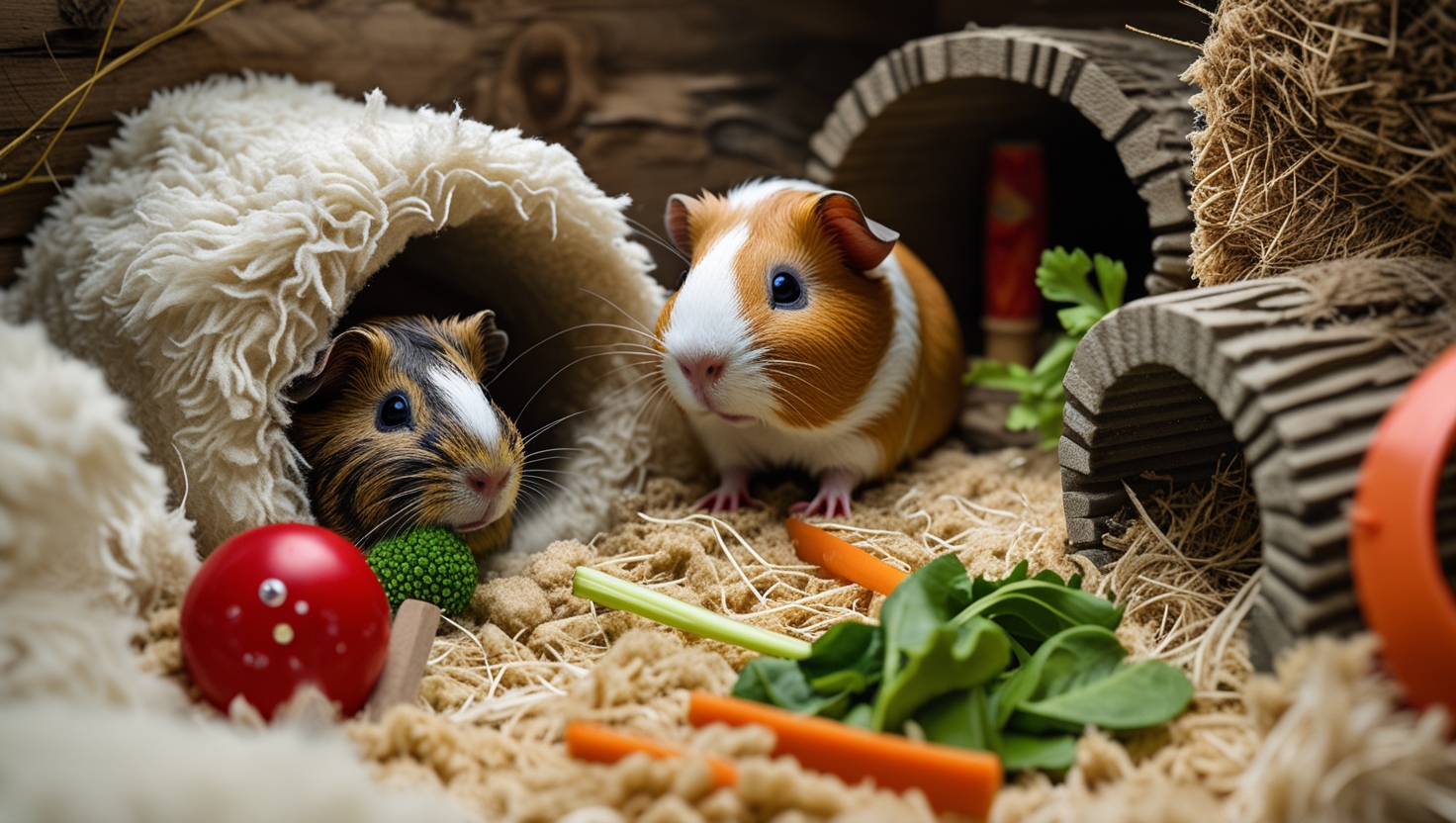Guinea Pig Cage Ideas: Setup & Decorations
Give your guinea pigs the perfect home with a well-planned cage setup! Optimize space with cozy hideouts, feeding zones, and exercise areas to keep them active and happy. Use safe bedding, proper ventilation, and fun decorations to create a stress-free, engaging environment. Whether it’s a DIY setup or a C&C cage, a thoughtful design ensures your furry friends thrive!
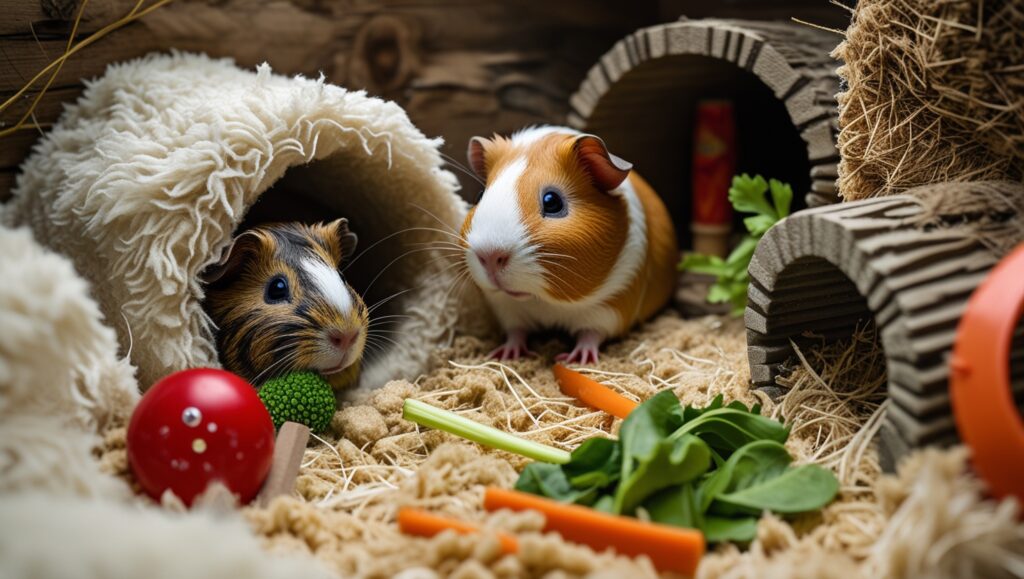
Introduction: Guinea Pig Cage Ideas: Setup & Decorations
Giving your guinea pigs a well-designed cage setup ensures they live in a safe, comfortable, and engaging environment. Whether you’re going for a DIY build or a C&C cage, the key is to optimize space while keeping their well-being a priority. A functional enclosure should include cozy hideouts, spacious exercise areas, and a hygienic feeding zone to meet all their needs.
To create the perfect living space, focus on proper ventilation, safe bedding, and creative decorations that add both style and function. Fleece liners, washable bedding, and removable trays make cleaning easier, while ramps, tunnels, and accessories help keep them active and entertained. Whether you’re working with a small cage or a large enclosure, thoughtful planning ensures your furry friends thrive in a stress-free, fun-filled home! 🐹✨
Guinea Pig Cage Setup Ideas
Looking for DIY guinea pig cage ideas online? You’ll find many fun and colorful designs that seem like the perfect addition to your home. Some setups even become a beautiful focal point in a room. But before you start building, think about your piggies’ wellbeing. Not all DIY cages are safe, so it’s important to steer clear of anything that doesn’t meet their needs.
A good guinea pig cage setup should include:
- Plenty of room to zoom, with at least a 4×2 C&C cage for two female guinea pigs.
- Proper ventilation to protect their sensitive respiratory system.
- A steady temperature, avoiding drafts and direct sunlight.
Avoid using:
- Old tables or plastic boxes, as they do not provide enough space or ventilation.
- Multi-level cages with steep ramps, which can lead to dangerous and life-threatening falls.
- Homemade cages without proper safety features, as they may not be sturdy enough.
Optimizing Space for Guinea Pigs
Creating a comfortable and functional space for your guinea pigs is essential for their well-being. Whether you prefer a C&C cage or a DIY-built setup, the key is to optimize the floor space efficiently. A custom-built or pre-bought enclosure should include sectioned zones for different activities, like an eating area, exercise layout, and hiding spots. Using correx/coroplast, or corrugated plastic sheets for the base ensures durability, while fleece liners, washable bedding, or disposable bedding simplify daily replacement and maintenance. If you’re considering an indoor cage, a bookcase or flat pack design can provide structural support while maintaining a well-rounded environment.
Indoor Cage Setup and Layout
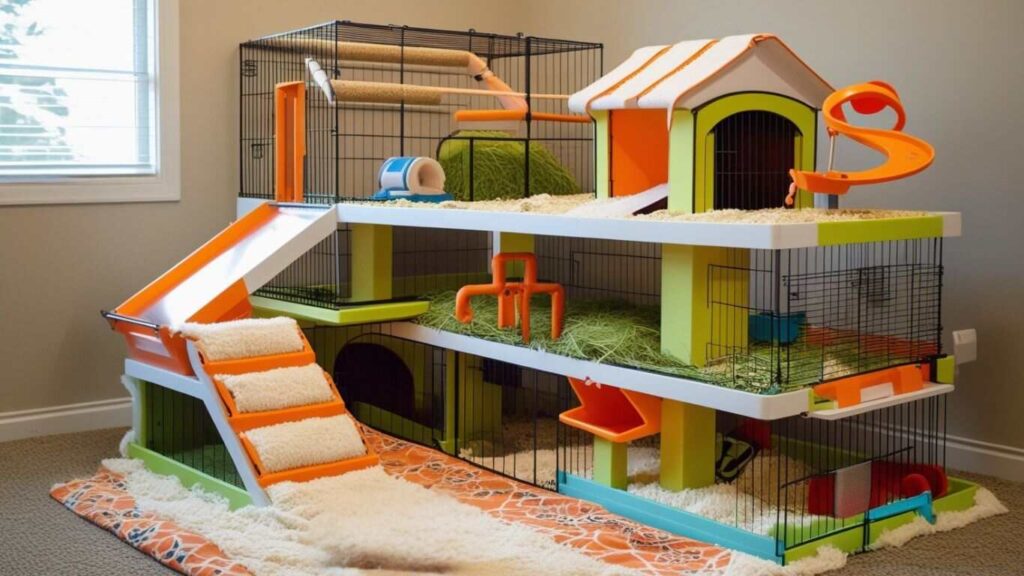
For an indoor cage, strategic placement of compartments and additions helps in creating a personalized and space-efficient enclosure. A stable door design can make access easier, while modular functional zoning ensures the setup is adaptable to your available floor space. Using noodle bathmats and bedding types that are easy to clean can simplify maintenance. A flat pack design with removable panels allows for expansion when needed, providing extra space for a herd. A structured L-shaped cage or two-tier setup can help maximize the exercise area while keeping an open feel.
Outdoor Housing and Weather Protection
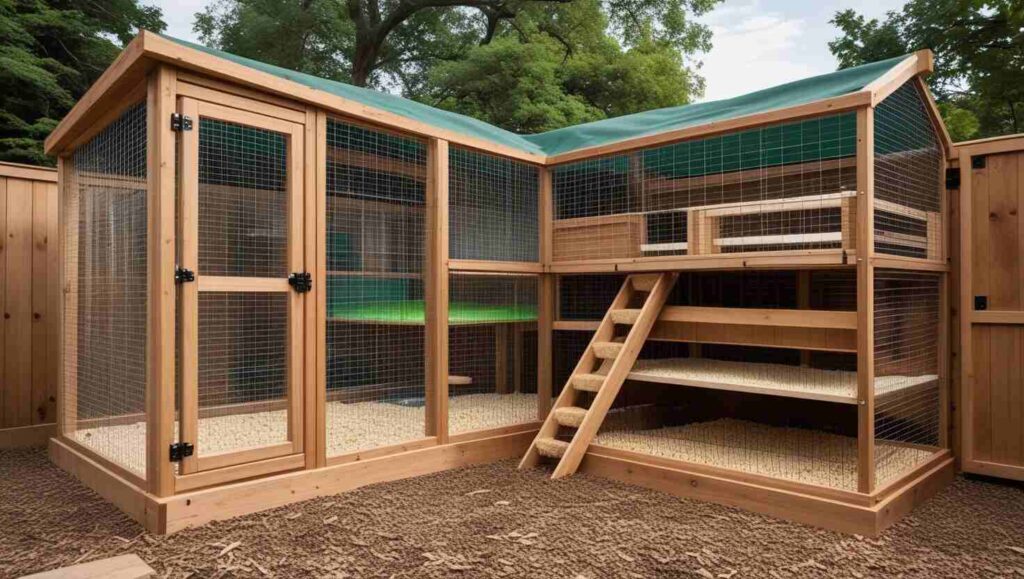
For outdoor housing, predator protection is essential, so using wire meshed walls, pond liner, and pet-safe paint will make the enclosure weather-proof, ensuring longevity. A wooden frame or metal frame with removable panels makes it easy to expand, adjust, or relocate. A two-tier setup or an L-shaped cage helps maximize the increased area, providing extra space for your herd. Adding loft boards or multiple levels creates resting spots, while a rubber matting base provides insulation and comfort. Stable doors or perspex panels offer easy access for cleaning day, making maintenance simpler.
Creative Layout and Functional Zoning
Strategic placement of hay trays and a creative layout contribute to a personalized enclosure. A shed can serve as a quieter spot for the piggies, offering protection from harsh weather. Using a stand allows for storage beneath the housing, keeping pig-equipment organized. If you prefer a semi-homemade approach, consider a portable setup with adaptable features that simplify daily care. DIY-built cages with modular elements help balance standard-sized and supersized enclosures while ensuring temperature control. Structural support is vital for two-tier designs, as proper strategic placement prevents instability.
Size, Exercise, and Traveling Considerations
When planning the setup, consider dimensions like 8ft by 6ft, 213cm by 71cm, or 265cm by 95cm to fit your available space. Whether you choose a flat pack style or a portable, adaptable build, an open-grid design allows for better airflow. An exercise area should be part of the layout plan to promote zoomies, and an enclosure height of at least 71cm by 71cm ensures comfort. Traveling with a predator-proof cage requires a functional zoning system, while structured, space-efficient enclosures work well for both small enclosures and larger enclosures. Refer to different innovative ideas for additions like compartments to further enhance the environment.
Essential Cage Features & Safety
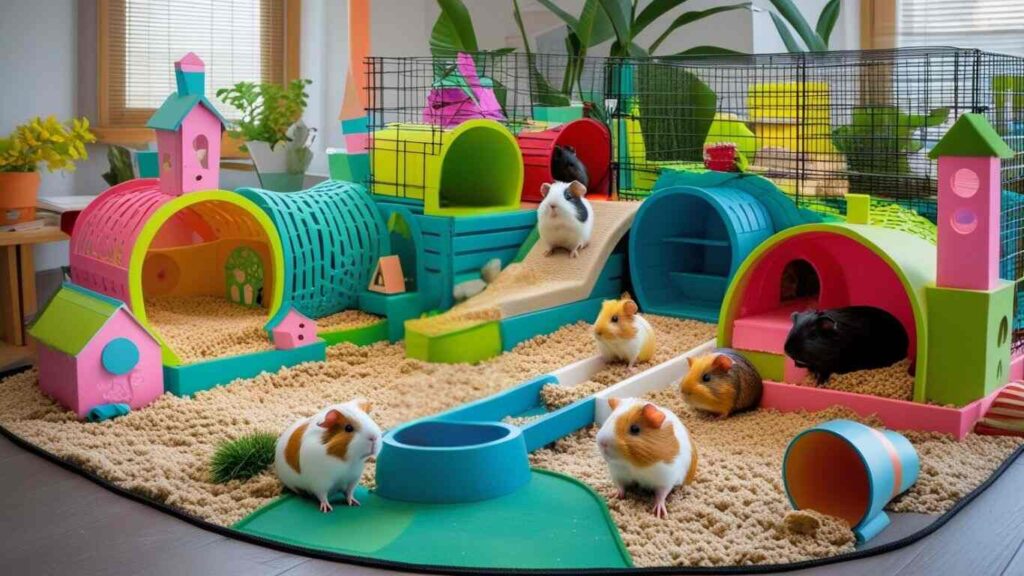
Spacious and Safe Housing for Guinea Pigs
A DIY guinea pig cage should be a colorful, fun space that serves as a focal point in your home. The minimum recommended size is 1.5m by 1m for a compatible pair or trio of piggies, ensuring they have enough room to zoom.
Proper ventilation is important to safeguard their sensitive respiratory system, preventing issues from drafts, direct sunlight, or unstable temperatures. Fleece liners, washable bedding, and pee pads keep the cage dry, comfy, and hygienic, reducing the risk of urine scalds on their feet.
Avoiding Unsafe Cage Setups
It’s important to steer clear of old tables, plastic boxes, and homemade improvised multi-level setups with steep ramps, as these are a downfall and can cause life-threatening falls. A safe setup should have hideouts and disposable, replaceable bedding for cleanliness. Planning and managing a practical enclosure design should include quiet, dark spots for sleeping, a designated feeding area, and an accommodation plan that allows for weekly extensive spot checks and change of bedding.
Strategic Placement for Safety and Accessibility
Strategic placement of accessories ensures easy access for cleaning while helping to eliminate health hazards and securing areas to prevent escapes. Endless options exist to enhance the cage decor, including wooden accessories, a cozy fall theme, or a minimalist aesthetic to bring joy and spice to the palace.
Adding Decor While Maintaining Functionality
Adding adorable decorations, like stylish prints, can create a stunning, natural-looking mood while keeping the space safe. A well-designed enclosure balances practicality and safety, ensuring a structured, secure environment for your furry friends to thrive.
Guinea Pig Cage Ideas: Setup & Decorations
Creating a guinea pig cage setup is an exciting way to give your floofy friends a fun, comfortable, and stylish home. A well-designed living space should be both functional and adorable, ensuring your piggies’ well-being while also becoming a beautiful centrepiece in your home. Whether you prefer a DIY approach or a homemade setup, your cage décor should reflect your personality while keeping your pets safe and happy.

A good setup should include cosy sleeping areas, spacious exercise zones, and easy-to-clean feeding space. Using C&C grids, fleece liners, and washable bedding helps maintain hygiene, while thoughtful decorations add charm. Get ready to explore some creative ideas to prettify your guinea pigs’ palace!
10 Guinea Pig Cage Decoration Ideas
1. Garlands or Bunting – Add a Festive Touch
Why not make your guinea pig cage look extra cheerful with homemade garlands or bunting? Using fabric scraps, quilt squares, ribbons, or even a piggy outline, you can create a fun, crafty décor piece that adds charm to the space. A glue gun or saw can be used to attach the decorations safely. This makes for a win-win afternoon project for both young and old guinea pig lovers! Just be sure there are no sharp edges or needles within reach of your furry friends.
2. Ornaments – Make Their Cage Shine
Want to add a little sparkle? Use adorable, shiny, stylish ornaments to decorate the cage bars. Clip them onto C&C meshing or tie them to the grids to match the season. You can switch them up for different seasonal themes like Halloween, Christmas, or even a fall-inspired look with wrapped parcels and warm colors.
3. Soft Toys – The Perfect Snuggle Buddies
Guinea pigs love comfort, and adding stuffed animals gives them something soft to snuggle with during their naps. Some piggies even use them as cuddle buddies, just like we do! Secure the toys to a grid using paper clips, and always supervise to ensure they don’t chew on anything unsafe.
4. Piggy-Safe Plants – A Natural and Edible Addition
Adding small plants brings a green, natural vibe to your setup. Consider cavy-savvy herbs like parsley or basil, which your piggies can graze on as a snack. Place them on a shelf or inside a pot so they can grow back after being nibbled. Be careful to steer clear of toxic plants, as they can make your floofs sick.
5. Hair Clips – A Small Yet Stylish Addition
For a little extra stylishness, attach hair clips in different colours, shapes, and patterns to the cage bars. Make sure they are placed high enough to prevent tangling or becoming a restrictive hazard for your piggies.
6. Ribbons – A Simple Way to Prettify the Cage
Decorating with ribbons adds an extra pop of colour to your guinea pig cage. Tie them along the coroplast base or weave them through the grids in different patterns to make the space feel more inviting. Just be sure to secure them properly so your piggies don’t end up chewing or getting tangled in them.
7. Magnets – The Perfect Travel Souvenir Display
If your cage setup includes steel-coated grids, why not use magnets to display souvenirs from your travels? It’s a great way to bring a bit of your own personality into your piggies’ home. Just be sure to secure them well so your chompers don’t decide to test their chewability!
8. Postcards & Photos – Add a Personal Touch
Make the cage setup even more special by adding postcards, childhood photos, or your favourite memories. Secure them to the bars using safe clips, or create a digital printout of a custom piggy collage. This will add interest to the space and make it truly unique.
9. Fancy Sticky Notes or Stickers – Fun and Functional Decor
Stickers and sticky notes aren’t just for fun—they can also help you organize pig-quipment! Label storage boxes or use bright, playful stickers to decorate the coroplast walls. This simple customization trick adds personality to the space while keeping things organized.
10. Lamps – Create a Cozy Ambience
A clip-on lamp or fairy lights can add a cosy glow to your guinea pig palace. It helps create a spotlight effect while making the space feel warm and inviting. However, all electricals and cables must be kept far out of reach to protect your piggies’ safety.
Essential Cage Features & Safety

Enrichment & Activity Ideas
Keeping your guinea pigs active and happy is essential for their well-being. A well-planned housing set-up with homemade enrichment can prevent boredom and encourage natural foraging behaviours. Below are some exciting and creative ways to keep your piggies entertained while making their cage setup stimulating and engaging.
Homemade Guinea Pig Enrichment
Adding DIY toys to your cage can make a huge difference in your piggies’ daily life. Cardboard balls stuffed with hay, tubes with hidden treats, and boredom breakers like ramps, tunnels, and fleece fabric hideouts create a stimulating environment with multiple entrances and exits for exploration.
Toilet Roll Tube Toy – A Simple and Fun DIY Idea
A toilet roll tube filled with hay or small treats makes an easy and fun DIY toy. This encourages snuggling, exploring, and nibbling while keeping their enclosure exciting. It’s a favourite enrichment idea because it’s simple, cost-effective, and safe for guinea pigs.
Reused Furniture – Repurpose for a Unique Cage Setup
Using Ikea drawers, ramp covers with Velcro, or small shelves can create hideouts, platforms, and exercise zones inside the cage. Reused furniture adds levels and depth to the setup, ensuring your guinea pigs have plenty of room to run and play.
Homemade Fleece Cage Accessories – Cozy and Practical
Fleece liners, fabric curtains, and soft bedding are great for keeping your guinea pigs comfy. Make sure to wash fleece 3 times, tumble dry to shrink the fabric, and avoid using scented soap or softener. A zigzag stitch when sewing layers makes the fabric more durable.
Creating a Stimulating Environment
Regularly changing the layout of your guinea pig enclosure keeps things exciting. Introduce new elements like ramps, tunnels, or small platforms to add variety. This allows your piggies to experience new areas and textures, keeping their daily routine fresh.
Exercise Areas – Essential for Healthy and Active Guinea Pigs
A sizable, open area is important for guinea pigs to run and play. A long, obstacle-free space meets their daily exercise needs and helps keep them active. Adding Haypigs treat balls filled with their favourite treats makes playtime more fun and rewarding.
Smart Cage Layouts for Different Sizes
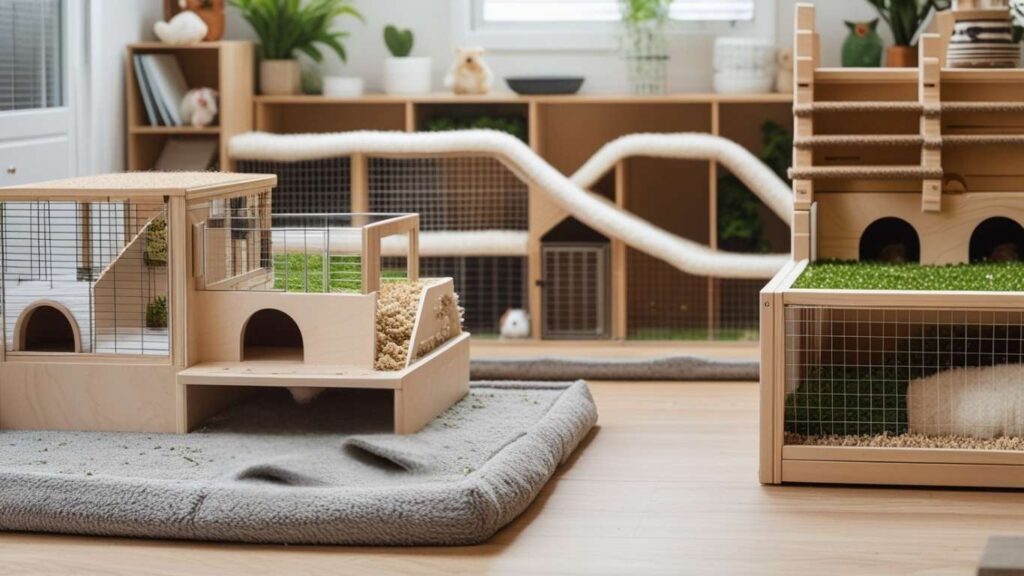
What Are Good Guinea Pig Cage Ideas for Small Spaces?
Designing a guinea pig cage depends on the space available and your piggies’ needs. In small spaces, a good-sized C&C cage is a fantastic choice as it allows for plenty of movement while maximising the area. For those with limited room, building upwards with levels or a two-tier stand is a great option to create spacious enclosures without overcrowding. A DIY build lets you shape the cage to fit the available form, ensuring comfort and a safe environment for your furry potatoes. Reading a blog about different cage ideas can help piggy parents find the best setup for everyday care.
For Smaller Cages – Smart Use of Space
If you have a smaller cage, using corner hideouts is ideal to provide cozy areas while keeping the layout appropriately sized. Including multi-level ramps or elevated hideouts helps maximize space while giving your guinea pigs room to move. Adding stands underneath allows for storage while maintaining a safe, comfortable environment.
For Larger Enclosures – Giving Guinea Pigs More Room
For larger enclosures, you can accommodate two or more piggies, allowing them to snuggle together or have their own space when they wish. Adding C&C cage expansions, bigger tunnels, and exercise areas ensures they remain active and engaged.
Upper Level for Resting – Creating a Cozy Retreat
A raised platform or upper level provides a quiet resting spot for piggies to relax. These can be made using Ikea drawers, ramp covers with Velcro, or DIY fleece-lined shelves. This gives them a safe, elevated space while keeping the lower cage area open for exercise and play.
Organizing Functional Areas in the Cage
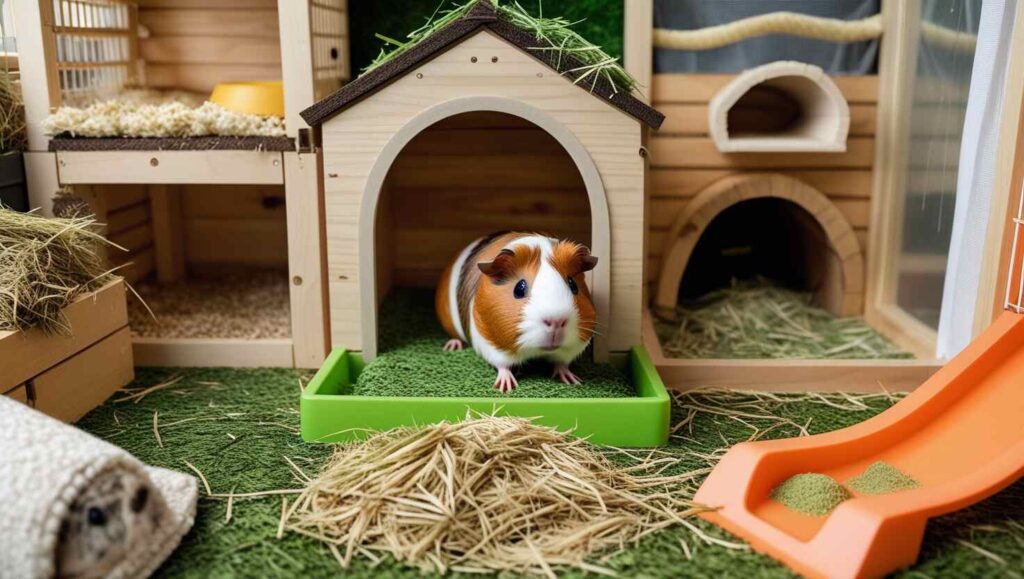
Eating Area – A Clean and Hygienic Feeding Space
A well-planned guinea pig cage should have specific sections to keep the space tidy and easy to maintain. A practical approach is to create a designated eating area, as piggies tend to urinate while they consume hay. Using absorbent bedding in this section helps keep it hygienic. A shallow litter tray placed in a dedicated feeding zone can make cleaning manageable while ensuring a distinct dining area for your pets.
Sleeping Quarters – A Secure and Comfortable Hideout
Adding a spacious hideout for them to sleep and feel secure is essential for their well-being. A large enclosure with separate sections for feeding, resting, and exploring makes the cage setup more efficient. Using popular ideas like a full-wall hideout or a bedding-lined space ensures individual comfort. A functional layout keeps the enclosure clean while allowing the piggies to enjoy their own space in a well-structured environment.
Exercise Areas – Space for Play and Movement
A spacious enclosure should include an exercise area to keep your guinea pigs active and healthy. Providing an open space with ramps, tunnels, and hideouts encourages movement and prevents boredom. Setting up a large play zone allows them to run, explore, and zoom freely. Keeping this area separate from the eating and sleeping sections ensures a functional cage layout that supports their natural behaviors while maintaining cleanliness.
Conclusion
Designing a comfortable, spacious, and engaging cage for your guinea pigs is key to their overall happiness and well-being. Whether using a C&C cage, DIY build, or store-bought enclosure, the setup should include cozy hideouts, safe bedding, a clean feeding zone, and plenty of exercise areas. Thoughtful decorations and enrichment keep them active and entertained, preventing boredom while ensuring a safe environment. Regularly reorganizing their space, using functional zoning, and incorporating interactive accessories help create a stress-free, stimulating home. With proper ventilation, hygiene, and structural safety, your piggies will thrive in a bright, comfortable, and engaging setup that encourages natural behaviors and happy, active lifestyles.
Kindly note: The content shared in this blog is gathered from online sources, some of which may not be verified. For accurate guidance on caring for your guinea pig, it is recommended to seek advice from a qualified veterinarian.
